 |
 |
 |
 |
|
 |
 |
|
 |
|
|
 |
|
|
|
 |
|
3. General Observations
3.1. Holes and Compounds. Pacioli’s original description refers to a cube within a shell of triangles. But if we take the alternative order of the faces around one of the cube vertices, we obtain instead a single intertwined double layer structure. And there is also another difference: the path around the cube vertices in the elevation gave us knot-shaped cutting lines for the holes in the construction instead of the simple loop-shape holes we got around the vertices of the octahedron in the elevated octahedron. In Figure 21 and Figure 22 rounded models, made on a 3D printer, of both the elevated octahedron and the elevated cube are shown. We can see that both objects are intertwined and double layered. The object of Figure 21 is an entwinement of two different parts, the object in Figure 22 is one single object. The shape of the holes in the elevated octahedron are simple loops, in the elevated cube we can recognize the trefoil knots.
|
|
|
 |
 |
|
|
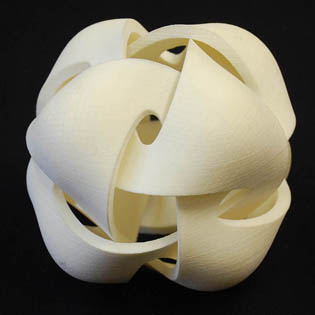 |
|
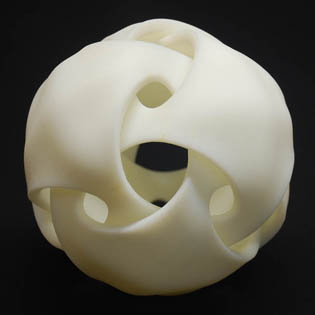 |
|
|
|
Figure 21: Elevated Octahedron.
|
Figure 22: Elevated Cube.
|
|
| 3.2. Questions. A few questions may arise: If we can make a knot-shaped path around a vertex of an elevated polyhedron, do we always get one single double layered entwined object? When we want to make a single double layered entwined object, is it only possible with knot-shaped holes? The answer to second questions is “No”, just because we can show a few counter examples as are shown in Figure 23 and Figure 24. But both these examples are built like a torus. And a torus has a higher genus then the sphere, the basic shape of the polyhedra that Pacioli used for the elevations. So the question might be: How can we understand this? In the elevated “spheres” the connectivity is determined by what happens locally around each original vertex. In the torus structures, the connection that turns these objects into single surfaces happens globally when traveling around the toroidal loop. |
|
|
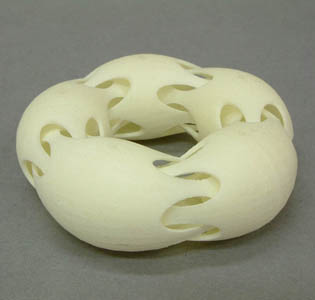 |
|
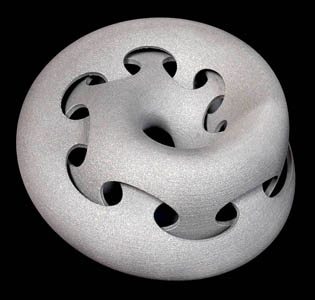 |
|
|
|
Figure 23: Double Skin Torus.
|
Figure 24: Trefoil Torus.
|
|
4. General Observations
4.1. Interwoven Layers. To get a better understanding of the connection between the shape of the holes and the number of parts in the construction, we start with structure of two interwoven surfaces as shown in Figure 25. All the holes in the construction are simple loops. Bending the construction will not change the properties of the holes (Figure 26). We can bend it so far that the left edges get connected to the right edges. But in this situation the right edge of one of the surfaces is connected to the left edge of the other surface and vice versa. So it is not two surfaces anymore, but one single interwoven surface, which is topologically equivalent to a double looped cylinder with a lot of holes (Figure 27).
|
|
|
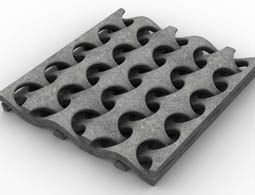 |
|
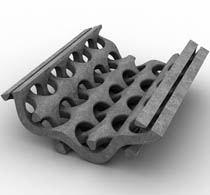 |
|
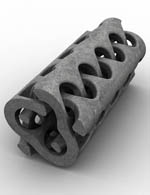 |
|
|
|
Figure 25: Interwoven Surfaces.
|
Figure 26: Bending.
|
Figure 27: Cylinder.
|
|
| 4.2. Knots. When forming the cylinder, the nature of the many holes has not changed. Do we have a single double layer entwined object without knot-shaped holes? The answer is No, because at the moment the construction closed to a cylinder two extra holes were generated at the two ends of the cylinder.For the doubly covered cylinder in Figure 27, the edges of these two holes would form trefoil knots. Whenever we have an odd number of ridges on the cylinder, these edges of the end holes form single torus knots and the resulting shape is a single surface. For an even number of ridges, we will get twoo intertwined torus knots and the result would be two separate, intertwined cylinder surfaces. And these holes can be seen as trefoil knots (Figure 28). |
|
|
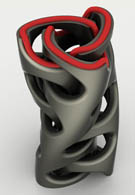 |
|
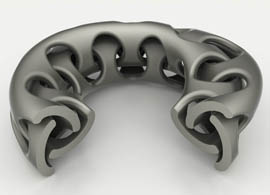 |
|
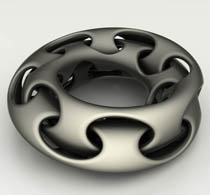 |
|
|
|
Figure 28: Knot.
|
Figure 29: Bending again.
|
Figure 30: Torus.
|
|
| 4.3. Torus. In the simplest case the cylinder has just 3 ridges and the holes at the two ends are bordered by simple trefoil knots. Several such cylinder elements could be stacked on top of one another, since the upper and the lower edge curve have the same shape and can thus readily be fused together. In the connection two knot-shaped holes will disappear, they will be transformed to single loops again, and so the total number of knot-shaped holes will be two again. There is another way to connect the upper side to the underside. We don’t need more copies of the structure, we can just bend again as in Figure 29. But then, when the upper side gets connected to the underside all knot-shaped holes disappear. We now have the situation that we have a single interwoven double layer object, but we needed to make it like a torus to get this result (Figure 30) which is similar to Figure 24. |
|
|
|
 |
|
|
|
|
|
|
|
|
|
|
|
|
|
|
|
|
|
|
|
|
|
|
|
|







